Luizi crater
Luizi is a meteorite impact structure that lies on the Kundelungu Plateau of Haut-Katanga province, in an underexplored region of southeastern Democratic Republic of the Congo.[1] The crater, ~17 kilometer in diameter, is visible from satellite imagery, and has been confirmed in 2011 by Ferrière et al.[2] as being caused by a large impact event. This complex meteorite impact crater is so far the only recognized one in the Democratic Republic of the Congo and even in the whole Central Africa.[3]
| Luizi crater | |
|---|---|
| Luizi impact structure | |
 Luizi impact crater in Democratic Republic of the Congo | |
| Impact crater/structure | |
| Confidence | Confirmed |
| Diameter | 17 km (11 mi) |
| Age | <542 myr (basement rock age) |
| Exposed | Yes |
| Drilled | No |
| Location | |
| Country | Democratic Republic of the Congo |
| Province | Haut-Katanga Province |
 Location of the crater in the Democratic Republic of the Congo | |
The crater was initially described as a semi-circular basin by German geologist E. Grosse in 1919.[4]

1973 satellite photo
See also
References
- "Luizi". Earth Impact Database. Planetary and Space Science Centre University of New Brunswick Fredericton. Retrieved 2016-04-08.
- Ferrière, Ludovic; Lubala, François R.T.; Osinski, Gordon R.; Kaseti, Pierre K. (2011). "The newly confirmed Luizi impact structure, Democratic Republic of Congo—Insights into central uplift formation and post-impact erosion". Geology. 39 (9): 851–854. Bibcode:2011Geo....39..851F. doi:10.1130/G31990.1.
- "Archived copy". Archived from the original on 2011-11-11. Retrieved 2011-11-22.
{{cite web}}: CS1 maint: archived copy as title (link) - E. Grosse, 1919. Grundlinien der Geologie und Petrographie des östlichen Katanga. Neues Jahrbuch Mineralogie, Geologie and Paläontologie, 42, 272–419. Google Book
This article is issued from Wikipedia. The text is licensed under Creative Commons - Attribution - Sharealike. Additional terms may apply for the media files.

